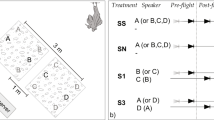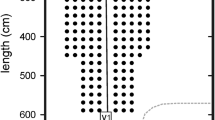Abstract
The prey pursuit behavior of Japanese horseshoe bats (Rhinolophus ferrumequinum nippon) was investigated by tasking bats during flight with choosing between two tethered fluttering moths. Echolocation pulses were recorded using a telemetry microphone mounted on the bat combined with a 17-channel horizontal microphone array to measure pulse directions. Flight paths of the bat and moths were monitored using two high-speed video cameras. Acoustical measurements of returning echoes from fluttering moths were first collected using an ultrasonic loudspeaker, turning the head direction of the moth relative to the loudspeaker from 0° (front) to 180° (back) in the horizontal plane. The amount of acoustical glints caused by moth fluttering varied with the sound direction, reaching a maximum at 70°–100° in the horizontal plane. In the flight experiment, moths chosen by the bat fluttered within or moved across these angles relative to the bat’s pulse direction, which would cause maximum dynamic changes in the frequency and amplitude of acoustical glints during flight. These results suggest that echoes with acoustical glints containing the strongest frequency and amplitude modulations appear to attract bats for prey selection.






Similar content being viewed by others
Abbreviations
- CF:
-
Constant frequency
- CF2 :
-
Constant frequency component with a second harmonic
- FM:
-
Frequency modulated
- iFM:
-
Initial frequency modulated
- PI:
-
Pulse interval
- TF:
-
Terminal frequency
- tFM:
-
Terminal frequency modulated
References
Corcoran AJ, Barber JR, Conner WE (2009) Tiger moth jams bat sonar. Science 325:325–327
Fenton MB, Fullard JH (1979) The influence of moth hearing on bat echolocation strategies. J Comp Physiol A Neuroethol Sens Neural Behav Physiol 132:77–86
Fujioka E, Aihara I, Watanabe S, Hosokawa Y, Kasai R, Hiryu S, Simmons JA, Riquimaroux H, Watanabe Y Rapid shifts of sonar attention to multiple prey items by foraging echolocating bats (under review)
Hiryu S, Katsura K, Lin LK, Riquimaroux H, Watanabe Y (2005) Doppler-shift compensation in the Taiwanese leaf-nosed bat (Hipposideros terasensis) recorded with a telemetry microphone system during flight. J Acoust Soc Am 118:3927–3933
Hiryu S, Shiori Y, Hosokawa T, Riquimaroux H, Watanabe Y (2008) On-board telemetry of emitted sounds from free-flying bats: compensation for velocity and distance stabilizes echo frequency and amplitude. J Comp Physiol A 194:841–851
Kober R, Schnitzler H-U (1990) Information in sonar echoes of fluttering insects available for echolocating bats. J Acoust Soc Am 87:882–896
Lancaster WC, Keating AW, Henson OW Jr (1992) Ultrasonic vocalizations of flying bats monitored by radiotelemetry. J Exp Biol 173:43–58
Lancaster WC, Henson OW Jr, Keating AW (1995) Respiratory muscle activity in relation to vocalization in flying bats. J Exp Biol 198:175–191
Link A, Marimuthu G, Neuweiler G (1986) Movement as a specific stimulus for prey catching behaviour in rhinolophid and hipposiderid bats. J Comp Physiol A 159:403–413
Mantani S, Hiryu S, Fujioka E, Matsuta N, Riquimaroux H, Watanabe Y (2012) Echolocation behavior of the Japanese horseshoe bat in pursuit of fluttering prey. J Comp Physiol A Neuroethol Sens Neural Behav Physiol 198:741–751
Matsuta N, Hiryu S, Fujioka E, Yamada Y, Riquimaroux H, Watanabe Y (2013) Adaptive beam-width control of echolocation sounds by CF-FM bats, Rhinolophus ferrumequinum nippon, during prey-capture flight. J Exp Biol 216:1210–1218
Miller LA, Surlykke A (2001) How some insects detect and avoid being eaten by bats: tactics and countertactics of prey and predator. Bioscience 51:570–581
Neuweiler G, Metzner W, Heilmann U, Rubsamen R, Eckrich M, Costa HH (1987) Foraging behavior and echolocation in the rufous horseshoe bat (Rhinolophus rouxi) of Sri Lanka. Behav Ecol Sociobiol 20:53–67
Novick A (1963) Pulse duration in the echolocation of insects by the bats, Pteronotus. Ergebnisse Biol 26:21–26
Sano A (2006) Impact of predation by a cave-dwelling bat, Rhinolophus ferrumequinum, on the diapausing population of a troglophilic moth, Goniocraspidum preyeri. Ecol Res 21:321–324
Schnitzler HU, Denzinger A (2011) Auditory fovea and Doppler shift compensation: adaptations for flutter detection in echolocating bats using CF-FM signals. J Comp Physiol A 197:541–559
Schnitzler H-U, Flieger E (1983) Detection of oscillating target movements by echolocation. J Comp Physiol A 153:385–391
Schnitzler HU, Kalko EKV (2001) Echolocation by insect-eating bats. Bioscience 51:557–569
Schnitzler HU, Ostwald J (1983) Adaptations for the detection of fluttering insects by echolocation in Horseshoe bats. In: Ewert JP, Capranica RR, Ingle DJ (eds) Advances in vertebrate neuroethology. Plenum Press, New York, pp 801–827
Schnitzler HU, Hackbath H, Heilmann U, Herbert H (1985) Echolocation behavior of rufous horseshoe bats hunting for insects in the flycatcher-style. J Comp Physiol A 157:39–46
Schuller G (1984) Natural ultrasonic echoes from wing beating insects are encoded by collicular neurons in the CF-FM bat, Rhinolophus ferrumequinum. J Comp Physiol A 155:121–128
Surlykke A, Filskov M (1999) Auditory relationships to size in noctuid moths: bigger is better. Naturwissenschaften 86:238–241
Suthers RA, Thomas SP, Suthers BJ (1972) Respiration, wing-beat and ultrasonic pulse emission in an echo-locating bat. J Exp Biol 56:37–48
Tian B, Schnitzler HU (1997) Echolocation signals of the greater horseshoe bat (Rhinolophus ferrumequinum) in transfer flight and during landing. J Acoust Soc Am 101:2347–2364
Trappe M, Schnitzler HU (1982) Doppler-shift compensation in insect-catching horseshoe bats. Naturwissenschaften 69:193–194
Vogler B, Neuweiler G (1983) Echolocation in the noctule (Nyctalus noctula) and horseshoe bat (Rhinolophus ferrumequinum). J Comp Physiol A 152:421–432
von der Emde G, Menne D (1989) Discrimination of insect wingbeat-frequencies by the bat Rhinolophus ferrumequinum. J Comp Physiol A 164:663–671
von der Emde G, Schnitzler HU (1990) Classification of insects by echolocating greater horseshoe bats. J Comp Physiol A 167:423–430
Acknowledgments
We thank Dr. Takuma Takanashi and Dr. Ryo Nakano for their valuable support. We also thank Nobutaka Urano for assistance in capturing bats in the field. This work was partly supported by a Grant-in-Aid for Young Scientists (A) (Grant No. 70449510) from the Japan Society for the Promotion of Science (JSPS). These experiments complied with the Principles of Animal Care, publication no. 86-23, revised 1985, of the National Institutes of Health, and with current Japanese laws. All experiments were approved by the Animal Experiment Committee at Doshisha University.
Author information
Authors and Affiliations
Corresponding author
Rights and permissions
About this article
Cite this article
Kinoshita, Y., Ogata, D., Watanabe, Y. et al. Prey pursuit strategy of Japanese horseshoe bats during an in-flight target-selection task. J Comp Physiol A 200, 799–809 (2014). https://doi.org/10.1007/s00359-014-0921-3
Received:
Revised:
Accepted:
Published:
Issue Date:
DOI: https://doi.org/10.1007/s00359-014-0921-3




